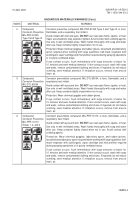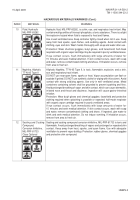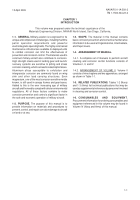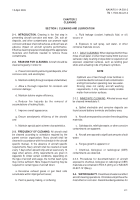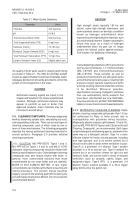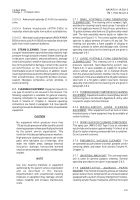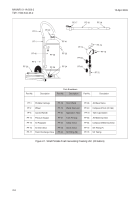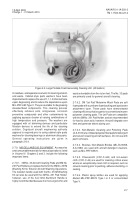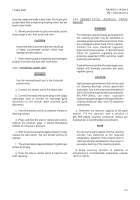TM-1-1500-344-23-2 - Page 27 of 240
2-3
NAVAIR 01-1A-509-2
TM 1-1500-344-23-2
15 April 2009
2-5.3. TURBINE ENGINE GAS PATH CLEANERS.
MIL-PRF-85704 (Cleaning Compound, Turbine Engine
Gas Path) is specially formulated for cleaning the
compressor section of gas turbine aircraft engines and
minimizing engine corrosion during wash cycles. Types I,
II, and III are supplied as concentrates and must be
mixed with water prior to use. Types II RTU and III RTU
are premixed and ready to use upon receipt. Types I, II,
and II RTU are intended for use with the engine off-line,
with the starter motoring the engine. Type I (solvent
emulsion concentrate with hydrocarbon solvents) works
by softening oily soils so that they can be emulsified by
the detergent. Local air pollution regulations may restrict
the amount and methods of application of Type I cleaner:
Types II or II RTU (aqueous cleaner without hydrocarbon
solvents) may be used as alternates. Types III and
III RTU are intended for use with the engine on-line
(fired). Because purified water is required to mix the
Type III concentrate and may be unavailable, use of
Type III RTU is recommended for on-line cleaning.
2-5.4. SPOT CLEANERS. The following three cleaners
(to be used without dilution) are approved for specific
localized applications in areas of heavy soil.
2-5.4.1. High Gloss Spot Cleaner. MIL–PRF–85570
Type III is recommended for cleaning exhaust track and
gun blast areas of high gloss paint systems. This
material contains solvents, detergents, and suspended
abrasive matter to remove soil by wearing away the
surface that holds it. It shall not be used on aircraft
painted with tactical paint schemes since it raises the
gloss of the surface.
2-5.4.2. Low Gloss Tactical Paint Scheme Spot
Cleaner. MIL-PRF-85570 Type IV is recommended for
cleaning exhaust track and gun blast deposits, smudges,
boot marks, and other embedded soils on low gloss
coatings. This material contains solvents, detergents,
and suspended rubber particles. When rubbed on a
soiled surface, the rubber particles act like tiny erasers,
removing soil by mechanically entrapping it in the rubber.
The gloss of tactical paint coatings is unchanged. For
more information on tactical paint schemes, see
Appendix A.
NOTE
Solvents in MIL-PRF-85570 Type IV cleaner
may be considered hazardous air pollutants
(HAPs). Consult local regulations before use.
MIL-PRF-85570 Type V may be used as an
alternate.
2-5.4.3. Thixotropic
(Viscous)
Cleaner.
MIL-PRF-85570 Type V is recommended for cleaning
wheel wells and wing butts, and replaces solvent cleaning
where water rinsing can be tolerated. This cleaner
contains solvents, detergents and some thickening
agents. When applied undiluted to an oily or greasy
surface, the cleaner clings long enough to emulsify the
soil (about 5 to 15 minutes) and can then be rinsed away
with fresh water. To perform most effectively, Type V
must be applied to a dry surface. Do not prerinse areas
of the aircraft that require application of Type V.
2-5.5. DETERGENT SOLUTION. MIL-D-16791
(Detergents, General Purpose Liquid Nonionic)
dissolved in water cleans by dissolving soluble salts,
emulsifying low viscosity oils, and suspending easily
removed dirt and dust. It is not very effective on grease,
but is an excellent cleaner for interior lightly soiled
areas, plastics, and instrument glass covers.
2-5.6. NON-AQUEOUS CLEANERS. MIL-PRF-32295
(Cleaner, Non-Aqueous, Low VOC, HAP-Free) is an
environmentally friendly chemical cleaner that is free of
hazardous air pollutants (HAP) and contains a very low
level of volatile organic compounds (VOC<25 g/l).
Because these cleaners do not contain water, they can
be used in areas where water-based cleaners are not
allowed. MIL-PRF-32295 can be used as a substitute
for MIL-PRF-680 in most applications. Type I is
recommended for removal of light soils (oils, dirt, CPCs).
Type II is a more effective cleaner for removal of heavy
soils (greases, carbonized oils, aged CPCs).
2-5.7. SOLVENTS. Cleaning solvents dissolve oils and
greasy soils so that they can be easily wiped away or
absorbed on a cloth. However, solvents differ significantly
in cleaning ability, toxicity, evaporation rate, effect on
paint, and flammability. MIL-PRF-680 Type II
Degreasing Solvent is the most common cleaning solvent
used on aircraft, due to its low toxicity, minimal effect on
paint, and relative safety. Other solvents, such as
alcohols, ketones, and aliphatic naphtha, are specialized
materials restricted for use.
Change 1 - 31 March 2010
Back to Top

